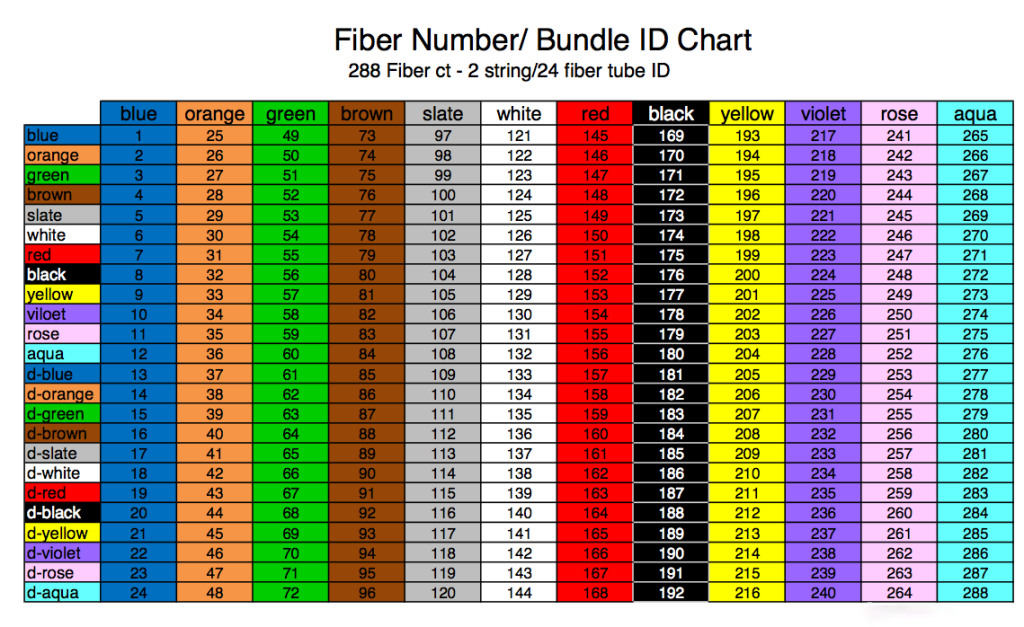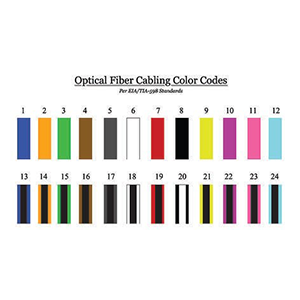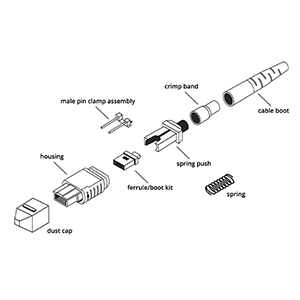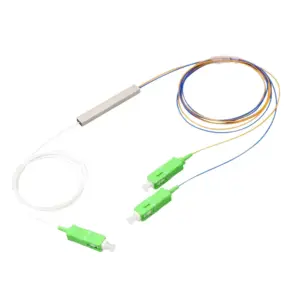Hello everyone! Today I am pleased to introduce you to an important concept that plays a key role in fiber optic cable management – fiber optic cable color coding. As a simple and effective identification method, fiber optic cable color coding can help us quickly distinguish different types of optical fibers and improve the efficiency of fiber deployment and maintenance. In this article, I will introduce to you in detail the standards of fiber optic cable color coding, common color meanings, and advantages in practical applications. I believe this will help you better manage and maintain fiber optic networks.
What is fiber optic cable color coding
TIA/EIA-598-C is a standard jointly issued by the Telecommunications Industry Association and the Electronic Industries Alliance to define the color coding of fiber optic cables. This standard is mainly intended to provide a unified identification method during the installation, maintenance and management of optical fiber networks, so that engineers and technicians can quickly and accurately identify the type and purpose of optical fiber cables.
Fiber optic cable color coding in TIA/EIA-598-C standard

- Blue – indicates single-mode fiber (SMF), which is widely used in long-distance, high-speed long-distance communication networks.
- Orange – Indicates 62.5/125μm multimode fiber (MMF), commonly used for short-distance, medium-speed indoor cabling and LAN applications.
- Green – indicates 50/125μm multimode fiber (MMF), which is also suitable for short-distance, medium-speed indoor wiring and LAN.
- Brown – Indicates 50/125μm high-band multimode fiber (OM3/OM4), used to support higher bandwidth applications.
- Gray – Indicates low-loss single-mode fiber (Low-Loss SMF), also used for long-distance communications.
- Yellow – Indicates single-mode high-power fiber (High-Power SMF), suitable for fiber sensing and laser applications.
- Purple – Indicates multimode fiber at 850nm wavelength. Typically used in optical systems and sensor applications.
- Red – Indicates multimode fiber at 1300nm wavelength. For fiber optic testing and measurement.
Color-coded fiber types and application scenarios
- Blue and gray single-mode optical fibers are mainly used in long-distance, high-speed communication networks, such as wide area networks, backbone networks, etc.
- Orange and green multimode optical fibers are suitable for short-distance, medium-speed LAN and indoor wiring applications, such as enterprise networks, campus networks, etc.
- Brown high-band multimode fiber can support higher bandwidth requirements, such as data centers and high-performance computing applications.
- Yellow single-mode high-power optical fiber is suitable for special application scenarios such as fiber optic sensing and laser.
- Purple and red multimode fibers are used for specialized applications at 850nm and 1300nm wavelengths respectively.
The role of color coding in improving fiber identification and routing efficiency
- Quick identification: Different colors can quickly and intuitively distinguish different types of optical fibers, reducing the risk of installation and maintenance errors.
- Application differentiation: Color coding helps distinguish optical fibers in different application scenarios, such as long-distance communications, local area networks, etc., to facilitate wiring and management.
- Anti-misconnection: Color coding can avoid misconnecting optical fibers of different specifications and reduce connection errors during installation and maintenance.
- Simplified maintenance: Color coding can simplify the connection and maintenance of fiber optic equipment and improve the reliability of the entire fiber optic system.
- Improving efficiency: Overall, color coding greatly improves the efficiency of identification, cabling and management of fiber optic systems.
So the fiber optic cable color coding defined in the TIA/EIA-598-C standard plays an important role in the installation, maintenance and management of fiber optic networks, improving identification and wiring efficiency, reducing errors and confusion, and promoting System standardization and consistency.
What are the common fiber color codes
Common fiber optic cable color coding is specified in the TIA/EIA-598-C standard, and these colors have different uses in single-mode and multi-mode fiber. Here is a detailed introduction to common color cables and their use in single-mode, multi-mode fiber and different applications:
Blue fiber optic cable
- Blue represents single-mode fiber (SMF)
- Mainly used in long-distance, high-speed communication networks, such as wide area networks and backbone networks
- Due to the low transmission loss of single-mode optical fiber, long-distance and high-bandwidth communication can be achieved
Orange fiber optic cable
- Orange represents 62.5/125μm multimode fiber (MMF)
- Suitable for short-distance, medium-speed LAN and indoor wiring applications
- Application scenarios such as enterprise network and campus network
Green fiber optic cable
- Green represents 50/125μm multimode fiber (MMF)
- Similar to orange multimode fiber, it is also suitable for short-distance, medium-speed LAN and indoor wiring
- Compared with 62.5/125μm multimode, 50/125μm has higher bandwidth performance
Brown fiber optic cable
- Brown represents 50/125μm high-band multi-mode fiber (OM3/OM4)
- Can support higher bandwidth requirements, such as data centers and high-performance computing applications
Gray fiber optic cable
- Gray represents low-loss single-mode fiber
- Similarly used in long-distance, high-speed communication networks
Yellow fiber optic cable
- Yellow represents single-mode high-power fiber
- Suitable for special application scenarios such as fiber optic sensing and laser
These color codes are important in distinguishing different types of fiber optic cables because they provide a simple and intuitive way to identify the type and purpose of fiber optic cables. By adopting a uniform color-coding standard throughout the network, engineers and technicians can quickly identify fiber optic cables, reducing the possibility of incorrect connections and confusion, and improving network reliability and maintainability. In addition, for networks that require frequent adjustments, maintenance, and expansion, color-coded standards simplify workflows, saving time and costs.
Fiber color coding application practice
In actual optical fiber network cabling, the application of optical fiber cable color coding is crucial. It can improve deployment and maintenance efficiency, and enhance network reliability and manageability. The following are some typical application cases and scenarios:
Application of optical fiber cable color coding in actual wiring
- In enterprise LAN deployment, orange and green multi-mode fiber optic cables are used to connect different floors or areas for easy differentiation and management.
- In the construction of the campus network, blue single-mode optical fiber is used to connect the backbone, and orange and green multi-mode optical fibers are used to connect each teaching building.
- In metropolitan area networks and wide area networks, blue single-mode optical fiber cables are widely used to achieve long-distance and high-speed transmission.
- Inside the data center, brown high-band multi-mode optical fiber is used to meet ultra-high bandwidth requirements.
- In special applications, use yellow single-mode high-power fiber optic cable to connect fiber optic sensing devices.
How color coding improves the efficiency of fiber optic network deployment and maintenance
- Quickly identify different types of optical fibers to avoid network failures caused by misconnections.
- Intuitively determine the application scenarios of optical fiber cables based on color, which facilitates wiring planning and management.
- Simplify maintenance personnel’s understanding and operation of optical fiber networks and improve maintenance efficiency.
- Record fiber optic cable information, including type, path, terminal, etc., to provide basis for later maintenance.
- Helps quickly locate and solve faults and reduce network interruption time.
Application of fiber optic cable color coding in different scenarios
- Data center: Use brown high-band multi-mode optical fiber to meet high bandwidth requirements, and blue single-mode optical fiber to connect core equipment.
- Telecom network: A large number of blue single-mode optical fibers are used to form the backbone of the wide-area communication network.
- Enterprise LAN: Orange and green multimode optical fibers are used for internal building wiring, and blue single-mode optical fibers connect the backbone.
- Special Applications: Yellow single-mode high power fiber optic cable is used in fiber optic sensing and laser equipment.
In short, fiber optic cable color coding standards play an important role in network deployment and maintenance, helping to improve the reliability and management efficiency of fiber optic systems. The flexible use of different colored cables in various application scenarios reflects the practicality and versatility of this standard.
How to manage and maintain optical fiber color coding
Color coding management in optical fiber networks is an important part of ensuring stable and efficient network operation. The following are the importance of fiber optic color coding management and maintenance, standardized methods for implementing standards, and key considerations for maintaining a color coding system:
The importance of color coding management
- Color coding is the basis for identifying and managing fiber optic cables and helps maintain the reliability of the entire fiber optic system.
- Standardized color coding helps simplify the deployment and maintenance of optical fiber networks and improve work efficiency.
- Uniform color coding standards facilitate collaboration and information sharing between different departments or projects.
- Complete color coding system records are an important basis for fault diagnosis and line changes.
How to standardize and implement color coding standards
- Strictly follow internationally recognized color coding standards such as TIA/EIA-598-C.
- Develop a detailed internal color coding management system to clarify the color correspondence of various types of optical fibers.
- Conduct color coding training for relevant personnel to ensure that everyone understands and implements unified standards.
- Establish an optical fiber cable ledger and record the type, color, origin and end point of each cable.
- Strictly enforce color coding requirements during fiber optic system construction and maintenance.
Notes on maintaining the color coding system
- Regularly check whether the color identification of optical fiber cables is consistent with the ledger records.
- Update ledger information in a timely manner to ensure that the latest changes in the optical fiber system are reflected.
- Promptly adjust color coding changes caused by malfunctions, modifications, etc.
- Strengthen the system construction of color-coded management and clarify the division of responsibilities and assessment standards.
- Regularly review and optimize the color coding system to ensure its adaptability and effectiveness.
The key to maintaining a color-coding system is ongoing management and supervision to ensure that the entire network remains compliant with the standards to improve network reliability and manageability. Consistency and accuracy of fiber optic cable color coding can be effectively maintained through training, documentation, regular inspections, and updates.
Future Development Trend of Optical Fiber Color Coding
The development of optical fiber color coding standards in the future will mainly focus on adapting to the needs of emerging optical fiber technologies and application scenarios, and playing a greater role in promoting the intelligence of optical fiber networks.
Color coding standard update direction
- As new fiber optic technologies continue to emerge, the existing TIA/EIA-598-C standard may need to be appropriately expanded and updated.
- For example, as data center applications grow in demand for higher bandwidth, new high-band multimode fiber colors may need to be added.
- In addition, as special applications such as fiber optic sensing develop, new colors may need to be added to represent high-power single-mode fiber.
Adapt to emerging technologies and application scenarios
- In the future, optical fiber networks will develop towards higher bandwidth and shorter latency, such as emerging communication technologies such as 5G and 6G.
- These emerging applications place higher demands on fiber transmission performance and may require new fiber types and color coding.
- In addition, emerging scenarios such as the Internet of Things and smart manufacturing will also expand the application of optical fiber and put forward new demands for color coding.
Intelligent function color coding function
- As optical fiber networks develop towards intelligence, the color coding system will play a more important role.
- Complete color-coded records facilitate intelligent management of fiber assets, such as line topology and fault diagnosis.
- Color-coded fiber optic cable information helps support intelligent applications such as automated deployment and maintenance.
- The intelligent optical fiber management system can monitor and analyze color-coded information in real time to improve network operability.
Taken together, the future development of optical fiber color coding standards will pay close attention to the needs of emerging technologies and application scenarios, including multi-mode and single-mode compatibility, high-density connections, intelligent management and automated configuration, to meet the growing demand for Growing demand for fiber optic networks.
Summary
Color coding of fiber optic cables is undoubtedly a very useful cable management technique. By using standardized color coding, we can easily distinguish different types of optical fibers, improving the efficiency of fiber identification and deployment. Whether in data centers, telecommunications networks or other application scenarios, color coding can play an important role in helping us build a more organized fiber optic network infrastructure.
We provide various types of prefabricated fiber optic cables and strictly follow color coding standards to ensure that you can easily manage and maintain your fiber optic system. If you have any questions about fiber optic cable color coding, please feel free to contact us for communication. Let us work together to build an efficient and reliable optical fiber network to facilitate the development of digital transformation!
fiber color codes FAQ
The standard fiber color order for optical fiber cables is: blue, orange, green, brown, slate, white, red, black, yellow, and violet.
The color order is standardized to provide a consistent and organized way of identifying and managing individual fibers within a cable. This helps in easy identification and organization, especially in high-density fiber installations.
The fiber colors are used to denote the specific function or purpose of the individual fibers. For example, blue is typically used for the first fiber, orange for the second, and so on.
Yes, the standard fiber color order applies to both single-mode and multimode optical fibers. The color coding is independent of the fiber type.
While the standard color order is widely adopted, there are some cases where the order can be modified or customized to suit specific project requirements or preferences. However, it is generally recommended to follow the established standard.
The color order helps in identifying and organizing individual fibers, especially in high-count fiber optic cables. It allows technicians to easily trace and manage specific fibers during installation, maintenance, and troubleshooting.
The standard fiber color order is generally consistent globally, as it is based on internationally recognized industry standards. However, there may be minor regional variations in some countries or specific applications.
While deviating from the standard color order is possible, it is not recommended, as it can lead to confusion and increase the risk of mistakes during installation and maintenance of fiber optic networks.
Yes, the standard fiber color order is applicable across different fiber optic cable types, including indoor, outdoor, and hybrid cables.
Maintaining the proper fiber color order is crucial for the efficient management and troubleshooting of fiber optic networks. It helps ensure consistent identification and organization of individual fibers, reducing the likelihood of errors and improving overall network reliability.




